
Zoom License Cost 2026: Which Plan Offers the Best Value for Your…
Table of Contents ToggleUnmanaged SaaS Creates Uncontrolled Costs and Increased RiskLicense...
Back
Back
Search for Keywords...
Blog

Table of Contents
SaaS lifecycle management has become a required discipline for enterprises in 2025. Rising software costs, the rapid adoption of AI-powered apps, and decentralized purchasing have prompted organizations to adopt structured oversight. The average organization adds 7.6 new unique applications to its environment every month, resulting in 91 new applications annually. That’s a staggering 33.2% year-over-year portfolio growth.
Unchecked growth of applications can lead to overspending and increased exposure to risk. Gartner forecasts global SaaS spending will climb to $299 billion in 2025, reinforcing the urgency of disciplined lifecycle practices.
By approaching SaaS as a continuous cycle—from procurement to renewal—leaders can lower costs, reduce risk, and ensure employees have the right tools at the right time.
When portfolios grow without oversight, organizations face immediate financial and security challenges, including:
The 2025 SaaS Management Index shows unused licenses contribute to an average of $21M in annual waste. Short one-year contracts gained favor in 2024, but the convenience often comes with higher pricing that compounds each year.
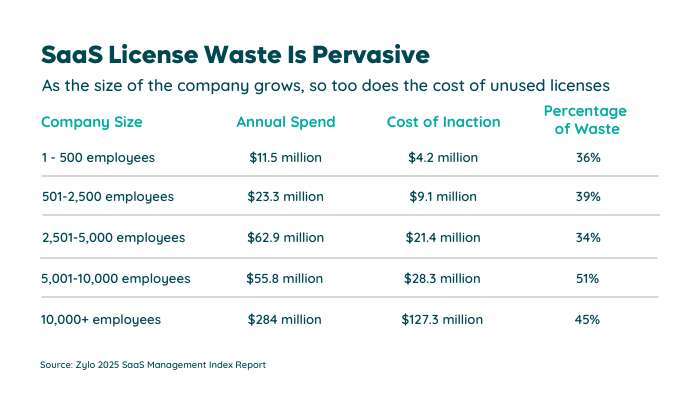
Decentralized purchasing continues to push costs upward. These factors drove SaaS spending to $4,830 per employee in 2024, representing a 21.8% year-over-year increase.
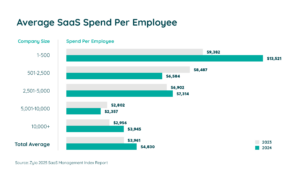
The risks extend beyond budgets. Nearly 90% of IT leaders expressed concerns about the security of AI tools, while 66.5% experienced surprise costs from usage-based or AI pricing models.

Shadow IT now accounts for a third of the average company’s applications, creating blind spots that weaken compliance and data protection. Without lifecycle management, contracts, owners, and renewals become difficult to track, leaving organizations exposed.
SaaS lifecycle management is the practice of overseeing each stage of a software application’s journey inside an organization. It includes:
The objective is to:
In 2025, the need for this discipline has accelerated. Organizations now manage an average of 275 applications and incur annual expenses of $49M. Portfolios are expanding, AI-native tools are reshaping contracts, and decentralized purchasing continues to grow. Lifecycle management provides a structured response through discovery, governance, and optimization.
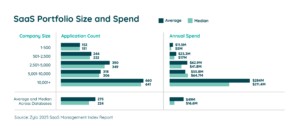
The lifecycle of SaaS applications follows a series of predictable stages. Each stage presents opportunities to enhance efficiency and mitigate risk when managed deliberately. The process includes:
The SaaS lifecycle begins with purchasing new software. To reduce risk, unnecessary spending, and over-buying organizations should have a clear purchasing policy in place. Collaboration between procurement, legal, security, and the business stakeholder provide checks that ensure new applications:
Consolidating procurement enhances visibility and facilitates more effective vendor negotiations. Beginning with SaaS discovery ensures that all applications—whether officially procured or not—are identified before new purchases are made.
Once purchased, applications move into implementation. This step determines how securely and effectively the tool integrates with existing systems. Establishing consistent standards for configuration, security, and data handling ensures compliance and avoids gaps created by fragmented rollouts.
Alongside implementation, a new application should be added to your system of record, like a SaaS Management Platform. Paired with app ownership, spend, and user activity, it becomes a reliable source of truth for stakeholders and enables optimization and renewal planning. Without a central record, contract details and usage data quickly become scattered and difficult to manage.
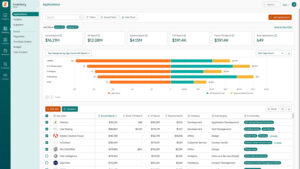
Licenses and features are often underused, costing organizations millions of dollars annually. Over its lifecycle, an application must be regularly audited and optimized. Optimization involves adjusting license tiers, reclaiming unused seats, and eliminating redundant apps to reduce waste and align spend with business needs.
The end of a SaaS application’s lifecycle is either renewal or termination. Evaluate renewal dates, analyze utilization data, and understand business value to determine whether to renew, renegotiate, or terminate. This stage is where disciplined lifecycle management delivers the largest financial impact—as renewal is the most pivotal time cost savings can happen.
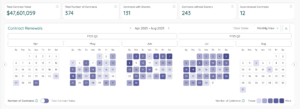
Building a SaaS Management program introduces its own set of challenges. Common pain points include:
Many organizations don’t have a complete picture of their software environment. Shadow IT, decentralized purchasing, and inconsistent reporting make it difficult to track what applications are actually in use. Without full visibility, leaders risk overspending and may miss compliance requirements.
Renewals often catch teams off guard. Without proactive monitoring, contracts can auto-renew at higher prices or for applications that are no longer needed. This reactive approach leads to wasted spend and missed opportunities for negotiation with vendors.
Even with a SaaS Management Platform, teams face heavy workloads if processes aren’t automated. Managing renewals, provisioning, and deprovisioning across dozens of apps can overwhelm IT and finance resources. Automating these workflows eases the burden, improves efficiency, and reduces the risk of human error.
Onboarding employees into SaaS applications creates additional complexity. Licenses must be provisioned correctly, and access should align with role-based policies. Inconsistent onboarding often results in unused seats, wasted spend, and security gaps.
Offboarding is a common failure point in SaaS lifecycle management. When access is not revoked at offboarding, former employees may still retain access to sensitive systems. This creates both compliance risk and excess cost. Automating offboarding through integrations with HR systems reduces these exposures, but many organizations struggle to maintain consistent processes.
The urgency surrounding SaaS Management is expected to continue growing in 2025. Rising costs, decentralized decision making, and rapid adoption of AI-powered apps have changed the dynamics of software ownership and spending. The most pressing challenges include:
SaaS purchasing has steadily moved away from central IT. In fact, more than 70% of SaaS spending is now managed by business units. Individual employees also introduce applications through expense reimbursements or corporate cards. This decentralization enables flexibility but reduces visibility, making it difficult to manage contracts, usage, and security.

Product-led growth strategies enable employees to easily start using new apps without requiring formal procurement. Many SaaS vendors rely on free trials or self-service signups to gain traction within companies.
These models often expand to enterprise contracts, sometimes before IT or finance has visibility into usage. The result is rapid adoption that bypasses traditional controls and accelerates sprawl.
Decentralized purchasing and product-led growth combine to fuel the growth of shadow IT. About one-third of the average company’s applications fall into this category. Shadow IT creates financial inefficiency by duplicating functionality across multiple tools. It also increases compliance and security risk, as unmanaged apps may not follow corporate policies or integrate with existing identity and access systems.
Beginning SaaS lifecycle management requires clear goals, dedicated ownership, and the right tools. Companies that align these elements early are more likely to drive business outcoms. Common steps include:
Define what SaaS Management should achieve for your organization. Decide whether your top priority is:
Bring IT, finance, and business leaders together to agree on shared outcomes. This alignment ensures the program measures success against the goals that matter most.
Stop relying on spreadsheets or legacy software management tools to track applications. Select a SaaS Management Platform that serves as the system of record for contracts, usage, and ownership. Connect it to your procurement and HR systems to build a complete inventory. Use the platform’s insights to negotiate renewals confidently and enforce governance with data.
Create a cross-functional team that owns SaaS lifecycle practices. Bring in stakeholders from IT, finance, procurement, and security to develop policies, oversee compliance, and drive optimization. Give the group a clear mandate so they can standardize best practices and extend them across departments.
Rank applications based on their cost, risk, and impact. Start with core productivity and collaboration tools, since they often account for the largest spend and present the highest risk. Focus your early efforts on high-value apps to deliver savings and security improvements quickly before turning to lower-priority tools.
Zylo’s Enterprise SaaS Management Framework guides organizations through a phased evolution—from basic discovery to fully operational programs. This structured approach helps teams build confidence, measure progress, and drive business impact through disciplined SaaS management.
This framework unfolds in phases that match organizational maturity and capacity:
The Definitive Guide to SaaS Management
Learn MoreEffective SaaS Management begins with clarity on what tools are in use and who controls them. Without discovery, teams make decisions based on assumptions rather than facts, leaving budgets, procurement, and security vulnerable. Building this foundation requires organizations to:
Organizations frequently underestimate their SaaS footprint by nearly 2X—according to Zylo research. Multiple discovery methods can help identify this footprint, each with its pros and limitations:
Relies on self-reports from technology-owning teams. It often falls short due to delays, inaccuracies, and a lack of continuous tracking.
Captures data flows between corporate networks and SaaS providers. However, it misses usage from unmanaged or personal devices, limiting coverage.
Installed on company-managed devices to track SaaS services accessed via browser. Lightweight and simple, but easily bypassed through private browsing or non-browser access.
Logs access to SaaS platforms wired through central identity providers. Offers strong visibility for managed apps, but doesn’t capture services outside the SSO environment.
Reviews expense reports, procurement records, and invoices to uncover apps outside IT’s radar. This method finds hidden deployments across business units, credit cards, and reimbursements.
Blending these methods provides the most accurate picture of a SaaS inventory, especially in complex or decentralized environments.
Discovery alone isn’t enough. Organizations also need to know who owns each application. Assigning responsibility ensures there is a clear point of contact for:
A system of record should document the business owners, IT sponsors, and finance partners associated with every tool. This structure prevents applications from falling through the cracks and establishes accountability for cost management and security oversight.
Clear ownership also streamlines decision making. When renewal negotiations arise or overlapping functionality is discovered, stakeholders know exactly who to involve. Documenting responsibility is especially important in decentralized environments where purchasing decisions occur outside of IT.
SaaS portfolios are constantly evolving. Continuous real-time monitoring ensures:
A SaaS Management Platform provides ongoing visibility into spend, usage, and compliance, alerting leaders when new tools emerge or when utilization patterns shift. This oversight transforms SaaS Management from a reactive process into a proactive discipline.
SaaS management continues to evolve as organizations adopt new technologies, pricing models, and operating structures. In 2025, three trends in particular are shaping how companies approach lifecycle practices:
Ownership of SaaS has shifted permanently from central IT to a mix of business units and software asset managers. Now that business functions outside of IT manage most SaaS spending, this decentralization requires collaboration between IT, SAM teams, finance, and business leaders. Effective programs combine centralized visibility with distributed accountability, ensuring that each group has the data needed to govern its share of the portfolio.
AI features have become standard in SaaS applications, from productivity suites to collaboration platforms. The 2025 Index reported that 66.5% of IT leaders encountered unexpected costs linked to AI pricing models, while 89.4% raised security concerns.
These figures highlight the importance of managing both financial and compliance implications as AI becomes more embedded. Going forward, discovery and contract reviews will need to account for AI-specific usage, licensing tiers, and data-handling requirements.
Subscription models are no longer uniform. Hybrid contracts that blend fixed seats with usage-based charges have become common. The 2025 SaaS Management Index indicates that these models are here to stay. For organizations, this means lifecycle management must include forecasting and monitoring consumption patterns in real time to avoid budget surprises.
Managing SaaS in 2025 requires more than ad hoc processes. Portfolios are larger, AI is embedded across various applications, and pricing models are changing rapidly. Without structured lifecycle management, organizations risk uncontrolled spend and increased exposure.
Zylo provides the data and framework to manage SaaS with confidence, cut waste, reduce risk, and operationalize SaaS Management at scale. Learn how license management, spend management, and governance equip leaders with the tools to take action. Request a personalized demo with one of our experts for a deeper dive.

Table of Contents ToggleUnmanaged SaaS Creates Uncontrolled Costs and Increased RiskLicense...

Table of Contents ToggleUnmanaged SaaS Creates Uncontrolled Costs and Increased RiskLicense...

Table of Contents ToggleKey Themes That Shaped SaaS Management in 20251....

Table of Contents ToggleUnmanaged SaaS Creates Uncontrolled Costs and Increased RiskLicense...
| Cookie | Duration | Description |
|---|---|---|
| cookielawinfo-checkbox-analytics | 11 months | This cookie is set by GDPR Cookie Consent plugin. The cookie is used to store the user consent for the cookies in the category "Analytics". |
| cookielawinfo-checkbox-functional | 11 months | The cookie is set by GDPR cookie consent to record the user consent for the cookies in the category "Functional". |
| cookielawinfo-checkbox-necessary | 11 months | This cookie is set by GDPR Cookie Consent plugin. The cookies is used to store the user consent for the cookies in the category "Necessary". |
| cookielawinfo-checkbox-others | 11 months | This cookie is set by GDPR Cookie Consent plugin. The cookie is used to store the user consent for the cookies in the category "Other. |
| cookielawinfo-checkbox-performance | 11 months | This cookie is set by GDPR Cookie Consent plugin. The cookie is used to store the user consent for the cookies in the category "Performance". |
| viewed_cookie_policy | 11 months | The cookie is set by the GDPR Cookie Consent plugin and is used to store whether or not user has consented to the use of cookies. It does not store any personal data. |
